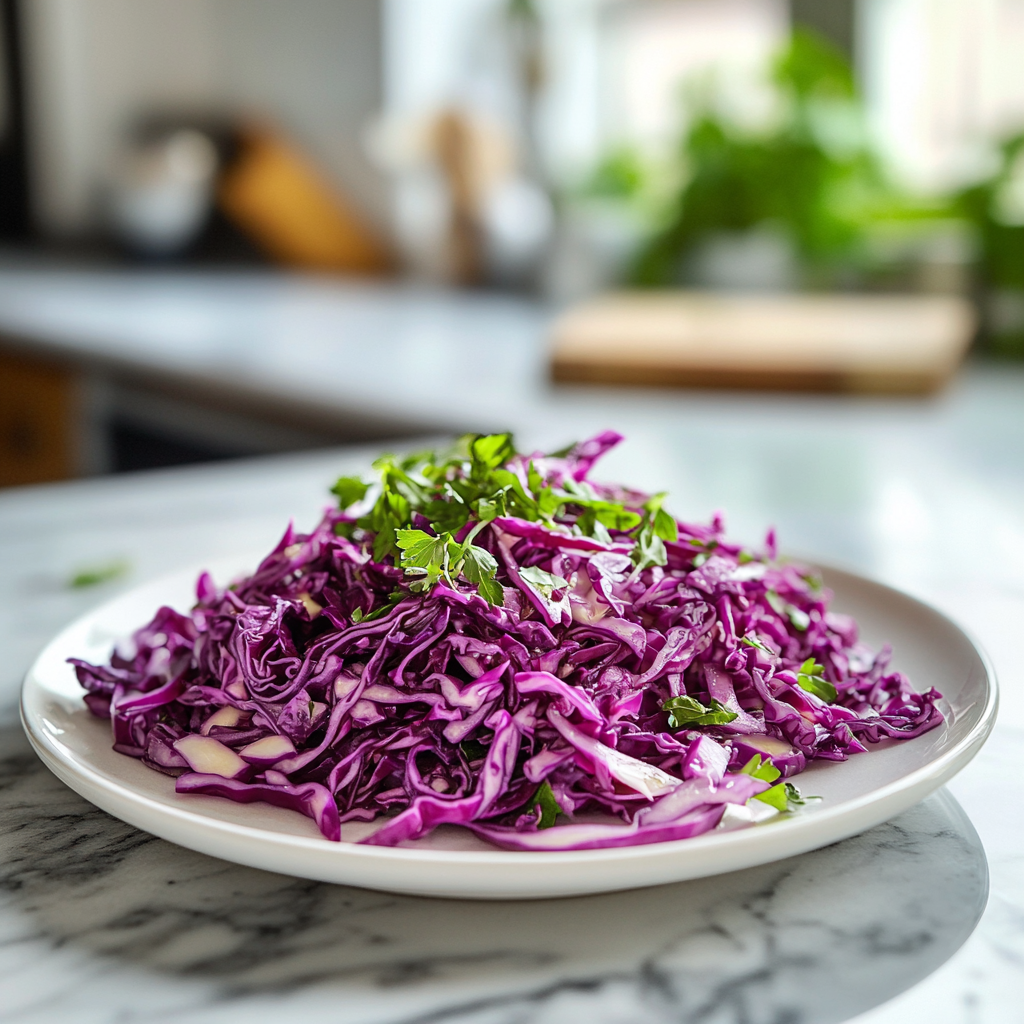Red cabbage is a vibrant and nutrient-rich vegetable that has long been celebrated for its culinary versatility and impressive health benefits.
In this comprehensive guide, you will discover the fascinating history of red cabbage, learn about its nutritional insights, and explore a variety of creative recipes, from classic braised dishes to innovative fusion creations.
Whether you are a seasoned chef or a home cook eager to experiment, this article is designed to provide you with the information and inspiration needed to transform red cabbage into a star ingredient in your kitchen.
Introduction
Red cabbage stands out not only for its beautiful deep purple hue but also for its impressive profile of vitamins, antioxidants, and fiber. This vegetable is a true powerhouse that can be used in an array of recipes, from warm, comforting stews to light, refreshing salads. The purpose of this guide is to offer a deep dive into the world of red cabbage recipes, helping you understand how to select the best produce, prepare it with care, and incorporate it into meals that are both delicious and nutritious.
In today’s health-conscious world, integrating nutrient-dense ingredients into our diets has become more important than ever. Red cabbage offers an excellent way to do this, as it provides a burst of color and flavor along with vital nutrients. For those who are interested in learning more about how nutrient-rich foods contribute to a healthy lifestyle, I recommend checking out the insightful article by the American Heart Association on Healthy Eating. Their comprehensive resources can help you further appreciate the role of vegetables like red cabbage in maintaining good health.
Historical Background and Nutritional Insights
The history of red cabbage is as rich and layered as its flavor. Originally cultivated in Europe, this vegetable became a staple in many traditional cuisines, particularly in Germany, France, and Eastern European countries. Over time, its unique taste and striking color allowed red cabbage to transcend cultural boundaries and become a beloved ingredient in kitchens around the world.
Historically, red cabbage was often served during festive celebrations and family gatherings, symbolizing abundance and prosperity. Over the centuries, culinary traditions evolved, but the nutritional benefits of red cabbage remained a constant reason for its continued popularity. Rich in vitamin C and vitamin K, red cabbage also contains powerful antioxidants that help combat inflammation and support a healthy immune system. Modern scientific research continues to validate these benefits, confirming that the anthocyanins found in red cabbage not only contribute to its vivid appearance but also play a role in reducing the risk of chronic diseases.
The nutritional insights into red cabbage make it an ideal addition to any diet. Whether you are seeking to boost your daily intake of essential vitamins or simply looking for a way to add more color and crunch to your meals, red cabbage offers an array of benefits. Its versatility means that it can be enjoyed raw in salads, lightly sautéed for a quick side dish, or slowly braised to create a rich and hearty accompaniment to your favorite main course.
Essential Ingredients and Tools for Red Cabbage Recipes
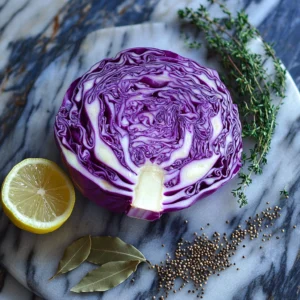
Before you begin your culinary journey with red cabbage recipes, it is important to ensure that you have the right ingredients and tools at your disposal. Fresh, high-quality produce is key to achieving the best flavor and texture in your dishes. Look for heads of red cabbage that are firm and heavy, with leaves that are crisp and brightly colored.
In addition to red cabbage, many recipes call for complementary ingredients that enhance its natural sweetness and add complexity to its flavor profile. Common companions include carrots, apples, and onions, which provide a perfect balance of savory and sweet notes. Spices such as caraway seeds, thyme, and bay leaves are often used to elevate the taste, while a splash of vinegar or lemon juice helps to brighten the dish and maintain the vegetable’s vibrant color.
Having the proper kitchen tools is just as important as selecting the right ingredients. A sharp knife and a sturdy cutting board are essential for finely slicing or shredding the cabbage. A large pot or deep skillet is ideal for braising, while a slow cooker can be used to develop a deep, rich flavor over several hours. For those who appreciate precision in the kitchen, understanding how to care for your tools is crucial. If you are interested in perfecting your knife skills, our detailed guide on How to Sharpen a Knife: A Comprehensive Guide offers valuable tips and techniques.
Basic Techniques for Preparing Red Cabbage
Selecting the Cabbage: Choose a fresh head of red cabbage and remove any damaged or wilted outer leaves.
Cleaning: Rinse thoroughly under cold water to remove dirt or impurities.
Slicing/Shredding:
- Slice evenly for consistent cooking.
- Thin strips for braising.
- Fine shredding for salads and coleslaw.
Cooking Methods:
- Boiling: Ideal for soups and stews.
- Steaming: Retains most nutrients.
- Sautéing: Quick and flavorful side dish.
- Slow-Cooking: Enhances flavor absorption.
Experimentation: Trying different techniques helps discover the best way to enjoy red cabbage.
For a more detailed exploration of cooking methods, you might consider reviewing our section on The Difference Between Slow Cooker and Crockpot, which explains how slow-cooking can transform even the simplest ingredients into gourmet meals.
Classic Recipe
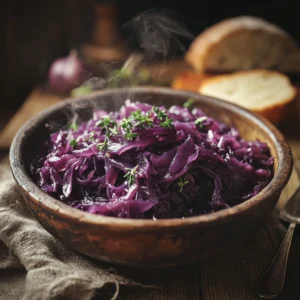
Braised Red Cabbage
Equipment
- Large pot
Ingredients
- 1 medium head red cabbage thinly sliced
- 2 tbsp olive oil
- 1 onion thinly sliced
- 1 apple diced
- 1 tsp caraway seeds
- salt and freshly ground pepper to taste
- 2 tbsp vinegar apple cider or red wine
- 1 tbsp sugar
- 1 cup vegetable or chicken broth
- fresh parsley or thyme for garnish
Instructions
- Heat olive oil in a large, heavy-bottomed pot over medium heat.
- Add the sliced onion and diced apple, cooking until softened.
- Stir in the sliced red cabbage and mix well.
- Add caraway seeds, salt, and pepper.
- Pour in the vinegar and sprinkle the sugar over the mixture.
- Add the broth and bring to a simmer.
- Cover the pot, reduce the heat to low, and let braise for 45 minutes to 1 hour, stirring occasionally.
- Adjust seasoning to taste and garnish with fresh parsley or thyme before serving.
Notes
For those who enjoy a modern twist on traditional recipes, our article on Mastering the Fried Chicken Tenders Recipe shows how red cabbage can serve as an ideal side to complement a variety of main courses.
Quick and Easy Red Cabbage Side Dishes
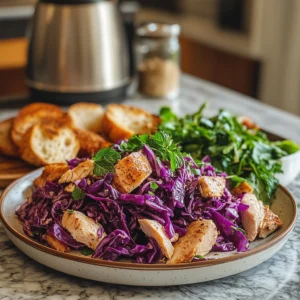
Not every recipe requires a long cooking process. Red cabbage is also a wonderful ingredient for quick, easy side dishes that can be prepared on busy weeknights. One popular option is a refreshing red cabbage salad. To create this dish, thinly slice or shred the cabbage and combine it with julienned carrots and a touch of lemon juice. The natural crunch of the cabbage, combined with the bright citrus flavor, makes for an invigorating addition to any meal.
Another simple preparation is a quick sautéed red cabbage. Heat a bit of olive oil in a pan, add minced garlic and a dash of ginger, and then toss in the sliced cabbage. A light seasoning of salt and pepper, perhaps with a drizzle of soy sauce, turns this simple dish into a flavorful accompaniment that pairs beautifully with rice or noodles. For those interested in exploring vegetable-based recipes further, our comprehensive guide on Frozen Spinach Recipes: A Comprehensive Guide can offer additional inspiration for integrating nutrient-dense ingredients into your meals.
For a refreshing twist on traditional coleslaw, try combining shredded red cabbage with a light yogurt-based dressing and some freshly grated carrots. This version of coleslaw is not only lower in calories than its mayonnaise-based counterpart but also offers a crisp, tangy flavor that can brighten up any plate.
Advanced and Innovative Red Cabbage Recipes
Creative Ways to Use Red Cabbage
- Fusion cuisine
- Try an Asian-inspired stir-fry with red cabbage, tofu, bell peppers, and a spicy ginger-soy sauce.
- The cabbage’s natural crunch and slight bitterness contrast beautifully with the savory and spicy flavors.
- Stuffed cabbage rolls
- Use blanched red cabbage leaves as wrappers.
- Fill with a savory mix of rice, ground meat or lentils, and aromatic herbs.
- Bake until flavors blend perfectly, combining innovation with tradition.
- Red cabbage as the star ingredient
- Incorporate into pasta sauces or grain bowls for a unique twist.
Shredded red cabbage can add an unexpected burst of color and texture when mixed into a hearty pasta sauce, while a well-composed grain bowl featuring quinoa, avocado, and red cabbage creates a satisfying and balanced meal. Our article on The Ultimate Guide to Eggplant Recipes provides additional ideas for how vegetables can be transformed into innovative main dishes.
Pairing Red Cabbage with Other Dishes
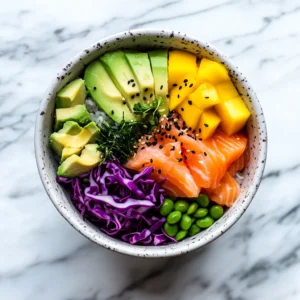
A well-balanced meal often relies on the harmonious pairing of flavors and textures. Red cabbage is an incredibly versatile ingredient that can enhance a variety of dishes.
When pairing red cabbage with other foods, consider its natural tanginess and crunch. For example, red cabbage pairs exceptionally well with seafood. A dish like our Lobster Pasta Recipe: A Gourmet Seafood Delight finds a perfect complement in the crisp and slightly sweet flavors of red cabbage.
Meats such as chicken and beef also benefit from the addition of red cabbage. The vegetable’s natural acidity helps to cut through the richness of roasted or grilled meats, providing a refreshing counterbalance to heavier flavors.
In addition, red cabbage can be a delightful component in salads and cold dishes. A well-crafted salad featuring thinly sliced red cabbage, mixed greens, and a light vinaigrette creates a refreshing contrast to more substantial main courses.
For those who appreciate a creative twist on traditional salads, our guide on The Guide to Tomato Cucumber Salad Recipe offers ideas that can easily incorporate red cabbage as an integral ingredient.
Frequently Asked Questions about Red Cabbage Recipes
Best storage methods
- Store in a cool, dry place or in the refrigerator.
- Keep in an airtight container to maintain freshness.
Reducing bitterness
- Add a touch of sugar or diced apples during cooking.
- Use acidic ingredients like vinegar or lemon juice to balance flavor and preserve color.
Eating raw
- Yes, red cabbage can be eaten raw.
- Perfect for salads and coleslaw due to its crunchy texture and slight peppery flavor.
For more in-depth tips on preparing and cooking red cabbage, you might want to explore our section dedicated to Red Cabbage Cooking Recipe.
Tips for Customizing Red Cabbage Recipes
Great adaptability of red cabbage
- Recipes can be adjusted to suit personal taste and dietary needs.
- For a spicier dish: add smoked paprika or chili flakes.
- For a milder flavor: enhance the cabbage’s natural sweetness with apples or carrots.
Easy dietary modifications
- Lower sodium: use low-sodium broth to reduce salt without sacrificing flavor.
- Vegetarian/vegan alternative: red cabbage works well as a substitute for meat-based ingredients.
- Customization with herbs: experiment with dill, parsley, or basil for added complexity.
Creative presentation
- Serve on a bed of quinoa or mixed greens for added texture and flavor.
- Garnish with fresh herbs or a squeeze of lemon for an eye-catching and delicious dish.
If you are looking for more inspiration on quick adaptations and creative twists, our article on Easy Weeknight Crockpot Meals is an excellent resource that demonstrates how simple adjustments can turn everyday ingredients into memorable dishes.
Conclusion
Red cabbage recipes offer a unique blend of tradition, nutrition, and innovation. Whether you are preparing a classic braised dish or experimenting with a fresh, modern salad, red cabbage has the versatility to shine in any culinary creation. This vegetable not only provides an array of essential nutrients but also serves as a beautiful canvas for both traditional and contemporary flavors.
By understanding the historical significance and nutritional benefits of red cabbage, you can appreciate its role in healthy cooking. The simple yet effective preparation techniques outlined in this guide will help you master the art of cooking red cabbage, whether you are creating a warm, comforting meal or a light, refreshing side dish. Experimenting with different ingredients, cooking methods, and presentation styles will allow you to tailor recipes to your unique taste and dietary needs.
The journey of exploring red cabbage recipes is one filled with opportunities to enhance your culinary skills and expand your palate. I encourage you to take the time to experiment, learn, and share your creations with family and friends. Embrace the versatility of red cabbage and let it transform your everyday meals into extraordinary culinary experiences.
For additional inspiration and practical tips, do not hesitate to check out our related recipes such as Brioche French Toast Recipe and Mastering the Fried Chicken Tenders Recipe. These articles offer further insights into how thoughtfully prepared dishes can become the highlight of any meal.
In summary, red cabbage is more than just a colorful vegetable. It is a testament to the beauty of natural ingredients and the endless possibilities they offer in the kitchen. Enjoy the process of discovering new flavors, techniques, and recipes as you incorporate this remarkable ingredient into your cooking repertoire. Happy cooking and bon appétit!

